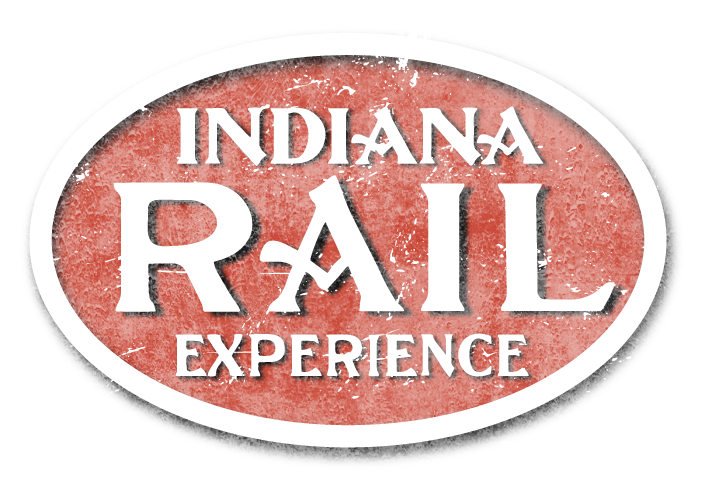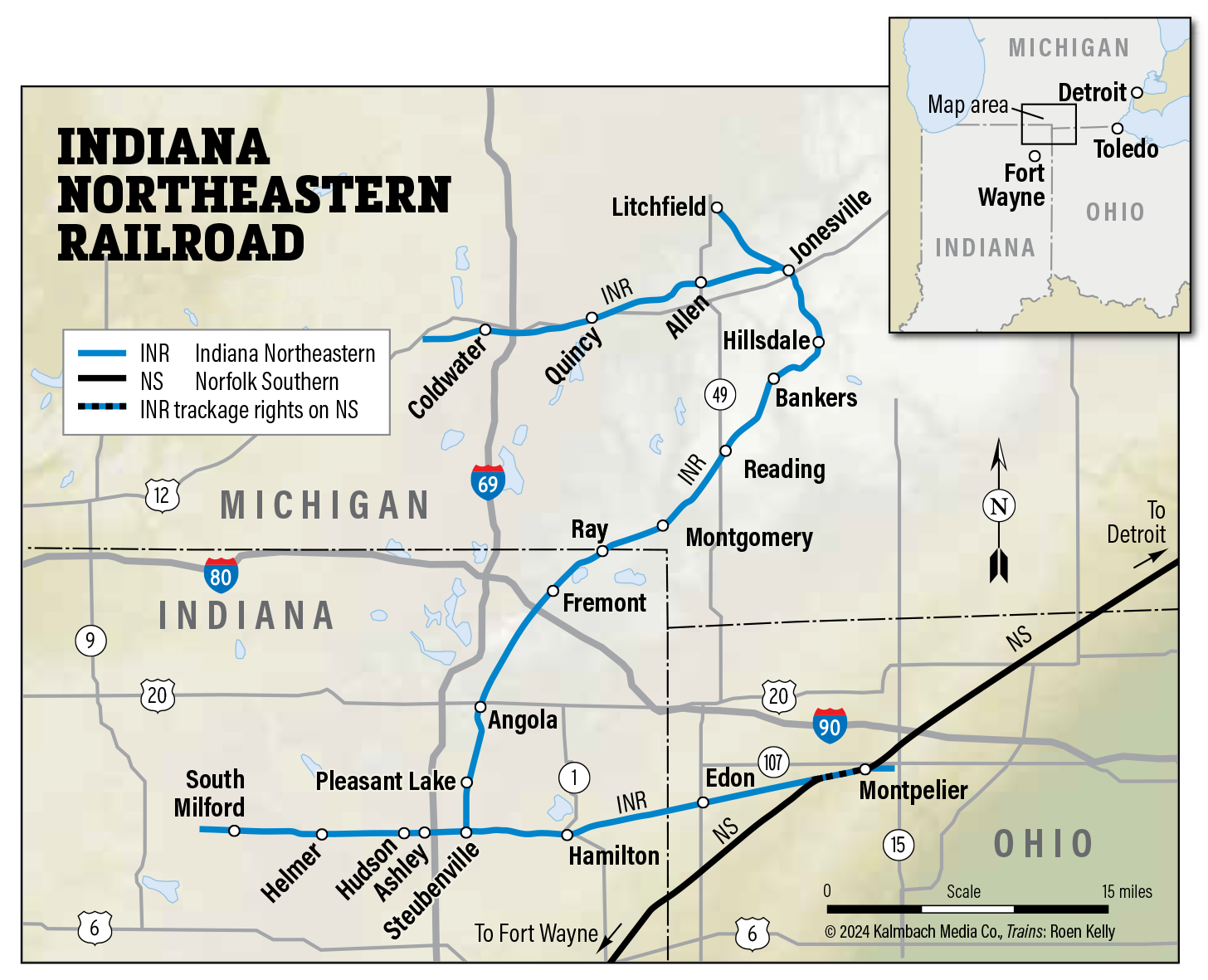THE NEW YORK CENTRAL ROUTE
Steubenville, Indiana
At the southern edge of Steuben County lies Steubenville, where the Fort Wayne & Jackson Railroad — chartered in 1872 — once crossed the Wabash’s Fourth District. Originally part of the mighty New York Central System, this route survived the turmoil of mergers and abandonments through Penn Central and Conrail before its southern end was removed. Today, the stretch from Steubenville north to Hillsdale, Michigan, remains active under the Indiana Northeastern’s stewardship.
Hillsdale, Michigan
Here, the former Fort Wayne & Jackson (FW&J) line meets the New York Central’s legendary “Old Road,” the system’s first rail route to Chicago from the east. Though later eclipsed by the Lake Shore & Michigan Southern’s faster “Air Line,” the Old Road persists under Indiana Northeastern operation as far west as Coldwater.
Pleasant Lake, Indiana
Nestled among the northern Indiana lakes, Pleasant Lake was once a resort destination and shipping hub. Ice harvested from the lake, gravel from nearby pits, and carloads of lumber, brick, and livestock once filled its sidings. The town’s 1882 Lake Shore & Michigan Southern depot still stands proudly, listed on the National Register of Historic Places. Across the tracks, the stone footings of a vanished water tank recall the age of steam. The line here crosses Pigeon Creek and threads north toward Long Lake and Mongo.
Angola, Indiana
Founded in 1838 and named for Angola, New York, this energetic town is home to Trine University, originally Tri-State Normal College. Its public square is anchored by a striking Civil War monument listing 1,278 Union soldiers from the area. The stately 1868 courthouse is crowned not by a rooster weathervane, but a fish — fitting for a county that proudly claims “101 lakes.” Nearby, Pokagon State Park remains a regional treasure, with its famed refrigerated toboggan slide and the grand Potawatomi Inn. In the early 1900s, the St. Joe Valley Interurban entered town from the northwest, passing beneath the FW&J near today’s State Road 127.
Fremont, Indiana
First called Willow Prairie, later Brockville, and finally Fremont in 1848, this town grew along the old Vistula Trail — now State Road 120. The railroad continues to serve local industries here, including a plastics manufacturer and a commercial bakery.
Ray, Indiana / Michigan Line
Straddling the state border, the hamlet of Ray once boasted a post office, stores, a mill, and a schoolhouse. Established in 1872, it remains one of the most scenic highlights of the route, its open fields and quiet crossing a favorite for photographers and passengers alike.
Montgomery, Michigan
Once whimsically known as “Frog Eye,” Montgomery was laid out with the coming of the railroad and planned as a junction for the never-completed Mansfield & Coldwater Railroad. The ghostly remnants of that unbuilt roadbed are still visible on the west edge of town.
Reading, Michigan
Originally “Basswood Corners,” Reading (pronounced REED-ing) is home to one of the Indiana Northeastern’s largest customers — The Andersons Trade Group — where thousands of carloads of grain begin their journey each year.
Bankers, Michigan
A once-bustling junction, Bankers marked the split between the original FW&J line to Jonesville and the Detroit, Hillsdale & Southwestern, later absorbed by the Lake Shore & Michigan Southern. East of Hillsdale, this became known as the Ypsilanti Branch.
Hillsdale, Michigan
County seat and cultural hub, Hillsdale is home to Hillsdale College, founded in 1844 — the same year the Michigan Southern Railroad reached town. By 1852, rails ran west to Chicago, and Hillsdale soon became headquarters for the New York Central’s Lansing Division. Sixteen passenger trains a day once served the town, and remnants of that era remain: the depot, division offices, and freight house — now slated for revitalization.
In 2022, steam returned when Nickel Plate Road no. 765 visited Hillsdale, the largest locomotive to appear there since the end of the steam era.
Jonesville, Michigan
Another crossroads of the New York Central, Jonesville’s 19th-century depot still stands — now a cozy bed and breakfast preserving the spirit of the line.
Quincy, Michigan
Settled in 1830 and named for Quincy, Massachusetts, the town blossomed along the old Sauk Trail, later known as the Chicago Road. Today, it serves as the turnaround point for the Little River Railroad, whose vintage trains offer runs through Michigan farm country.
Coldwater, Michigan
Originally Masonville, Coldwater now serves as headquarters for the Little River Railroad, whose steam excursions depart from the beautifully preserved Lake Shore depot. Together, Coldwater and Hillsdale mark the northern domain of the Indiana Northeastern — the last active stretch of what was once a vast New York Central network reaching Adrian, White Pigeon, and beyond.
THE WABASH ROUTE
Pergo, Ohio
The Wabash’s Fourth District begins just west of Montpelier, Ohio, at a junction known as Pergo. Once part of a bustling through-route to Chicago, 37 miles remain in service today under the Indiana Northeastern, connecting with Norfolk Southern at Montpelier and linking the region to the national network.
Edon, Ohio
Rails reached Edon in 1893, just in time to carry travelers to the World’s Columbian Exposition in Chicago. The town’s Wabash depot has been relocated several times and now rests preserved in a public park. Edon remains an agricultural stronghold, shipping hundreds of carloads of grain and fertilizer each year.
Hamilton, Indiana
Perched on the Steuben–DeKalb County line, Hamilton grew around a modest mill pond that became a lakefront resort. Two passing tracks remain, allowing trains to meet and freight to be sorted on this still-busy stretch.
Ashley, Indiana
Founded as a company town in 1892 and named for Wabash president O. D. Ashley, this was once the division point for the Wabash’s Detroit–Chicago line. Though division offices later moved to Montpelier, Ashley remains active with several local industries served by the Indiana Northeastern.
Hudson, Indiana
Neighboring Ashley, Hudson is home to the railroad’s primary locomotive and maintenance shop, where mechanics handle everything from inspections to full overhauls.
Helmer, Indiana
Helmer retains a long passing siding and once served as the junction for a short Wabash branch line to Stroh, built to reach a cement plant there.
South Milford, Indiana
This unincorporated community is home to South Milford Grain — the enterprise that began it all. While the main track ends two miles west of the elevator, the facility continues to dispatch thousands of carloads of corn, soybeans, and wheat each year. From these quiet sidings, the heartbeat of Midwestern commerce still pulses along the rails.

